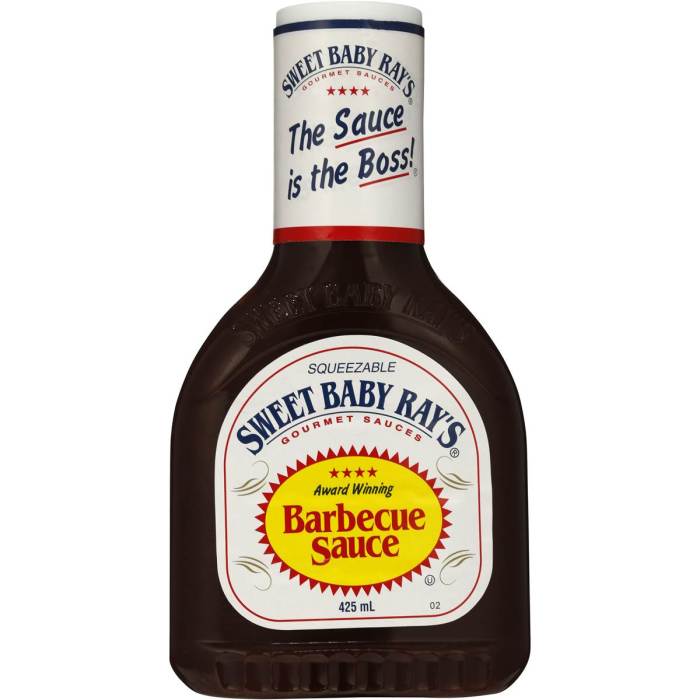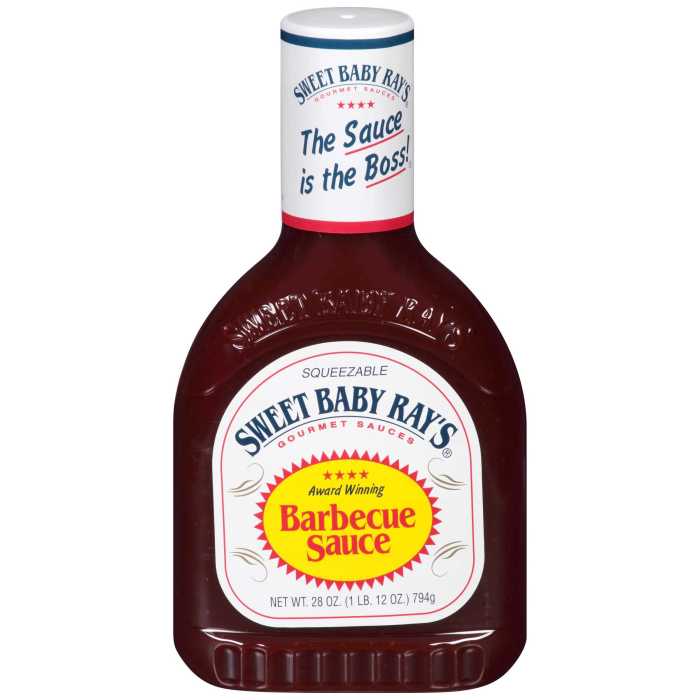Baby Rays BBQ Sauce Recipe A Homemade Guide
Cracking the Baby Ray’s BBQ Sauce Code: A Homemade Recipe Guide: Baby Ray’s Bbq Sauce Recipe

Source: woolworths.media
Baby ray’s bbq sauce recipe – Baby Ray’s BBQ sauce is a beloved staple for many, known for its balanced flavor profile and versatile application. This guide delves into the sauce’s flavor components, provides a recipe for homemade replication, explores variations, and offers a detailed visual representation of the process and the final product. We’ll analyze its characteristic taste, break down its likely ingredients, and guide you through creating your own version at home.
Baby Ray’s BBQ Sauce Flavor Profile
Baby Ray’s BBQ sauce boasts a distinctive flavor profile characterized by a harmonious blend of sweetness, tanginess, and savory notes. The dominant flavors stem from a careful balance of key ingredients. The sweetness is moderate, avoiding overwhelming cloyingness often found in other brands. The tanginess, provided primarily by vinegar, is equally balanced, preventing an overly acidic taste.
Compared to brands like Sweet Baby Ray’s (which is sweeter) or KC Masterpiece (which is often smokier), Baby Ray’s occupies a middle ground, offering a more versatile flavor profile suitable for a wider range of meats and applications. The sauce has a smooth, relatively thin consistency, coating food evenly without being overly thick or watery.
Recipe Deconstruction and Ingredient Analysis
Based on its taste and common BBQ sauce components, a likely ingredient list for Baby Ray’s includes tomato paste or puree, vinegar (likely a combination of apple cider and white vinegar for balance), brown sugar or molasses for sweetness, spices (paprika, onion powder, garlic powder, cumin, and perhaps a touch of cayenne for heat), and salt. The tomato provides the base, the vinegar the tang, the sugar the sweetness, and the spices the depth of flavor.
Baby Ray’s BBQ sauce recipe often incorporates a touch of heat, and for those seeking to amplify that fiery element, consider experimenting with different chili additions. A great starting point could be the vibrant flavors found in this asian hot pepper sauce recipe , which might add a unique complexity to your Baby Ray’s base. The resulting blend could offer a fascinating fusion of sweet, smoky, and spicy notes.
The exact proportions are proprietary, but we can estimate a plausible homemade version.
Below is a possible ingredient list and a comparison table highlighting differences between our estimated Baby Ray’s recipe and a generic BBQ sauce recipe:
| Ingredient | Baby Ray’s (estimated) | Generic BBQ Sauce | Difference |
|---|---|---|---|
| Tomato Paste/Puree | 1 (28 ounce) can | 1 (28 ounce) can | Similar |
| Apple Cider Vinegar | 1/2 cup | 1/4 cup | More tang in Baby Ray’s |
| White Vinegar | 1/4 cup | 0 | Added brightness in Baby Ray’s |
| Brown Sugar/Molasses | 1 cup | 3/4 cup | Slightly sweeter in Baby Ray’s |
| Paprika | 2 tablespoons | 1 tablespoon | More paprika for color and flavor |
| Onion Powder | 1 tablespoon | 1 tablespoon | Similar |
| Garlic Powder | 1 tablespoon | 1 tablespoon | Similar |
| Cumin | 1 teaspoon | 1/2 teaspoon | More cumin for warmth |
| Cayenne Pepper | 1/2 teaspoon | 0 | Adds a subtle heat in Baby Ray’s |
| Salt | 1-2 teaspoons (to taste) | 1 teaspoon (to taste) | Potentially more salt for balance |
Methods and Procedures for Homemade Replication

Source: coltrades.com
This section Artikels the steps for creating a homemade version of Baby Ray’s BBQ sauce. The process involves preparation, cooking, and finishing stages, with simmering time crucial for developing the flavors.
- Preparation: Combine all ingredients in a large saucepan.
- Cooking: Bring the mixture to a simmer over medium heat, stirring frequently to prevent sticking. Simmer for at least 30 minutes, allowing the flavors to meld. Longer simmering times (up to an hour) will result in a thicker, more concentrated sauce. Maintain a gentle simmer; avoid boiling, which can scorch the sauce.
- Finishing: Taste and adjust sweetness, tanginess, and spice levels to your preference. You can add more brown sugar for sweetness, vinegar for tang, or cayenne pepper for heat. Once satisfied, remove from heat and let cool slightly before transferring to a container for storage.
Variations and Adaptations
Several variations can be created by adjusting key ingredients. This allows for customization based on personal preferences.
| Variation Name | Key Ingredient Change | Flavor Profile | Notes |
|---|---|---|---|
| Smoky Baby Ray’s | Add 1 tablespoon liquid smoke | Smoky, sweet, tangy | Use a high-quality liquid smoke for best results. |
| Spicy Baby Ray’s | Add 1-2 teaspoons chili powder or a pinch of chipotle powder | Spicy, sweet, tangy | Adjust the amount of chili powder based on desired heat level. |
| Sweet Baby Ray’s | Increase brown sugar to 1 1/4 cups | Very sweet, tangy | Balance the sweetness with a slightly increased amount of vinegar. |
Visual Representation of the Recipe and Process, Baby ray’s bbq sauce recipe
Baby Ray’s BBQ sauce has a rich, dark reddish-brown color. Its consistency is smooth and slightly viscous, not overly thick but substantial enough to coat food well. During simmering, the sauce will initially appear somewhat watery, gradually thickening and darkening as the liquid reduces. The final product should have a glossy sheen and a uniform consistency, free from lumps or clumps.
The visual changes during the cooking process are subtle but noticeable. Initially, the mixture is a somewhat chunky blend of ingredients. As it simmers, the ingredients combine and the sauce becomes smoother and more homogenous. The color deepens, and the sauce starts to thicken, eventually reaching a glossy, dark reddish-brown hue. The reduction stage is visually apparent as the sauce noticeably decreases in volume and becomes more concentrated.
Popular Questions
What type of vinegar is best for this recipe?
Apple cider vinegar is traditionally used and provides a balanced sweetness and tang, but white vinegar can also be used for a sharper flavor.
Can I use a different sweetener?
Yes, brown sugar, honey, or maple syrup can be substituted for granulated sugar, each offering a unique flavor profile.
How long will the homemade sauce last?
Properly stored in the refrigerator, the sauce should last for about a week. For longer storage, consider freezing it in airtight containers.
Can I adjust the spice level?
Absolutely! Add more cayenne pepper or a dash of your favorite hot sauce for extra heat.





















